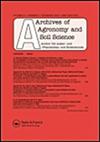Preparation, characterization and nitrogen availability of nitrohumic acid as a slow-release nitrogen fertilizer
IF 1.8
4区 农林科学
Q1 AGRONOMY
引用次数: 0
Abstract
ABSTRACT Nitrohumic acids (NHAs) are considered as promising slow-release N fertilizers. In this study, NHA was produced from six organic feedstocks, including coal, leonardite, municipal waste compost, sewage sludge, and apple and beech biochars via nitration using nitric acid. The nitration process was conducted in two ways: (i) after humic acid (HA) extraction (NHAD), and (ii) before HA extraction (NHAID). The prepared NHAs were then characterized using FT-IR and CHNS analysis. Additionally, N mineralization of NHAs was investigated in a sandy loam soil sample. The FT-IR spectra showed that both methods of nitration loaded nitro (NO2) groups into the HA structure. However, the CHNS analysis indicated the highest rate of N increase for NHAD (106%) and NHAID (113%) extracted from leonardite. Moreover, on average, the total acidity and carboxylic groups of the HAs increased by 7.5% and 14.5% after the nitration processes, respectively. The highest extraction yields of NHAD (26.1%) and NHAID (42.1%) were also obtained from leonardite. Although the extraction yield of NHAID was on average two times higher than that of NHAD, NHAD indicated a higher soil N availability (1.4 times). We concluded that the NHAD extracted from leonardite could be considered as an alternative slow-release N fertilizer.硝基腐殖酸缓释氮肥的制备、表征及氮素有效性
摘要硝基腐殖酸(NHAs)被认为是一种很有前途的缓释氮肥。在本研究中,利用六种有机原料,包括煤、褐煤、城市垃圾堆肥、污水污泥、苹果和山毛榉生物炭,通过硝酸硝化生产NHA。硝化过程分为腐植酸(HA)提取后(NHAD)和腐植酸提取前(NHAID)两种方式。然后用FT-IR和CHNS分析对制备的NHAs进行了表征。此外,还研究了砂壤土样品中NHAs的N矿化。FT-IR光谱分析表明,两种硝化方式均将硝基(NO2)负载到HA结构中。然而,CHNS分析显示,从龙纳地石中提取的NHAD(106%)和NHAID(113%)的N增加率最高。经硝化处理后,总酸度和羧基平均分别增加7.5%和14.5%。NHAD的提取率最高(26.1%),NHAID的提取率最高(42.1%)。NHAD的土壤氮有效度比NHAD高1.4倍,但NHAD的土壤氮有效度比NHAD高2倍。综上所述,从菱铁矿中提取的NHAD可作为缓释氮肥的替代肥料。
本文章由计算机程序翻译,如有差异,请以英文原文为准。
求助全文
约1分钟内获得全文
求助全文
来源期刊

Archives of Agronomy and Soil Science
AGRONOMY-SOIL SCIENCE
CiteScore
5.50
自引率
4.20%
发文量
107
期刊介绍:
rchives of Agronomy and Soil Science is a well-established journal that has been in publication for over fifty years. The Journal publishes papers over the entire range of agronomy and soil science. Manuscripts involved in developing and testing hypotheses to understand casual relationships in the following areas:
plant nutrition
fertilizers
manure
soil tillage
soil biotechnology and ecophysiology
amelioration
irrigation and drainage
plant production on arable and grass land
agroclimatology
landscape formation and environmental management in rural regions
management of natural and created wetland ecosystems
bio-geochemical processes
soil-plant-microbe interactions and rhizosphere processes
soil morphology, classification, monitoring, heterogeneity and scales
reuse of waste waters and biosolids of agri-industrial origin in soil are especially encouraged.
As well as original contributions, the Journal also publishes current reviews.
 求助内容:
求助内容: 应助结果提醒方式:
应助结果提醒方式:


